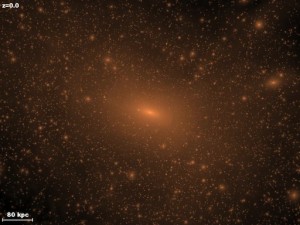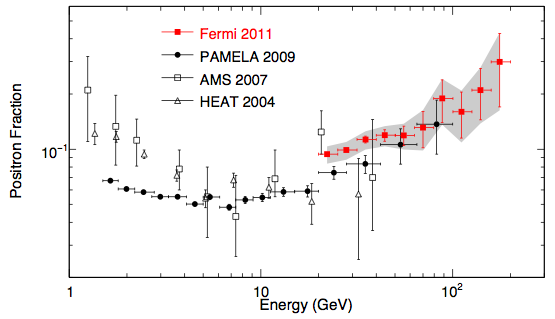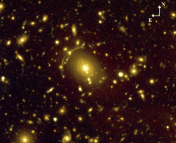TITLE: Searching for Dark Matter Satellites using the Fermi-LAT
AUTHORS: Fermi-LAT Collaboration
Dark matter is not so dark as the name might imply. Although it so far refuses to interact with normal matter via any force other than gravity, there are secondary signals that we can detect. If dark matter is, as the current leading theory predicts, comprised of a single light particle not accounted for in the Standard Model (the “Weakly Interacting Massive Particle,” or WIMP, model), then this WIMP should annihilate with itself in a reaction that produces a pair of photons. Given the energy range we believe the WIMP must have, those photons ought to be in the gamma-ray band. Thus, when we turn our gamma-ray telescopes on regions like the Galactic Center that contain a high density of dark matter, we expect to see a dim, widespread gamma ray haze coming from seemingly empty space, with no baryonic matter source (baryon is from the Greek for “massive particle,” but confusingly, while dark matter particles are certainly massive, they are not referred to as baryons — baryon means “normal stuff we can see”). This paper, due to be published by the Astrophysical Journal, discusses the search for this signature by the collection of satellites that surrounds the Milky Way, and uses the lack of a detection to set an upper limit on the cross-section of the WIMP particle.

The annihilation of dark matter particles (here shown as supersymmetric neutralinos, one candidate for the WIMP) into gamma rays and other secondary particles. Image credit: NASA/GLAST collaboration
The Large Area Telescope (LAT) on board the Fermi satellite has been searching for this so-called annihilation signature since it was launched; so far, no dice (otherwise I promise you this article would contain many more exclamation points). Part of the reason we may not have detected this signal yet is that it is not as simple as pointing Fermi towards the biggest nearby clump of dark matter and waiting to see something. The most obvious place to search for an annihilation signature is the Galactic Center, but that region unfortunately hosts a number of other interesting and gamma-ray-emitting objects such as pulsars and supernova remnants, plus the supermassive (and gamma-ray-loud) black hole Sgr A* at the middle of it all. So another, less obvious place to look is outwards, towards the dwarf spheroidal satellites orbiting the Milky Way. These small satellites have had most of their stars stripped away, because their gravity is not strong enough to hold them in long, but the dark matter remains more or less intact. Thus we ought to see a dark matter signal emanating from these cores – weaker than that from our galaxy, but less obscured as well, and not confused by as many other baryonic (normal stuff) sources.

Via Lactea dark matter simulation of a Milky-Way-sized halo. Brighter colors represent denser material. The major central object represents the Milky Way, surrounded by hundreds of smaller dark matter clumps ranging in size. Image credit: Via Lactea collaboration.
In the gorgeous high-resolution simulations of the Via Lactea, which models only dark matter, the Milky Way appears as a golden hive surrounded by swarms of smaller halos that buzz around its central potential. In real life these orbiting dark matter halos represent satellite galaxies, often dwarf spheroidals, that fall into our galaxy over time. Most people are familiar with the Large and Small Magellanic Clouds, the Milky Way’s largest and most distinct satellites, but in fact several smaller galaxies orbit ours, many in the process of being torn up and absorbed by the Milky Way proper. These satellites have had their gas and dust and most of their stars stripped away, but their dark matter halos remain. One of the largest, the Draco Dwarf, may have a mass-to-light ratio as high as 440, i.e. for every sun’s worth of light coming from the satellite, there are 440 solar masses of material; this suggests the presence of a large remnant dark matter halo.
So these dark matter-dominated satellites provide an excellent place to look for the elusive gamma-ray annihilation signature without being confused by other sources. Fermi-LAT studied the Draco Dwarf and 13 other known dwarf spheroidals and found no evidence of a gamma ray signature. However, it is possible – indeed highly likely – that there are dark matter clumps in the Milky Way’s halo that do not have stars associated with them. The Fermi-LAT team therefore went back and reanalyzed their data to look for any extended gamma ray sources with no optical counterparts. If there are any major nearby dark matter clumps, we should see them as extended, non-power-law gamma ray sources emitting a faint signal from an area containing no known optical objects.
The team began with their existing Fermi source catalog, 1FGL, and cut out all the objects near the Galactic disk in order to exclude everything that was a part of the Milky Way proper. Then they looked for any sources without optical counterparts. This yielded 231 candidates for dark matter clumps. The source catalog, however, was assembled under the assumption that sources were points and had power law spectra. Since neither of these are expected to hold for a diffuse dark matter annihilation source, which will be spread across the sky and emit in a non-power-law way, the team went back and reanalyzed their data, relaxing these two constraints. This gave them 154 new sources, which, combined with the original sources, gave a total of 385 candidates for emitting dark matter clumps. They then screened these candidates looking for sources that were spread out over a significant region of sky. Only 2 sources made this cut; 1 passed the followup spectral cut.

Flux values vs. spectral hardness for sources identified in the 1FGL catalogue (black) and in the larger Fermi dataset (red), plus 193 spurious sources from a Monte Carlo simulation of background only (blue).
Although 2 sources out of 385 does not seem like a lot, it would be a major find to pick out two dark matter clumps based on gamma ray signatures alone. However, upon further examination, the team found that both candidates have baryonic (normal stuff) explanations: one was associated with a millisecond pulsar by radio followup, and the other appears to be associated with a dual Active Galactic Nucleus (AGN). So the Fermi-LAT team concluded that no unassociated, spatially-extended sources, the sort that could be attributed to dark matter clumps, were found after all.
Given the number of Milky Way satellites predicted by the Via Lactea and Aquarius simulations, this non-detection gives an upper bound for the interaction cross-section of 1.95 × 10-24 cm3 s-1 for a 100 GeV WIMP (the larger the cross-section, the more the WIMPs should interact and annihilate with each other, and the brighter the corresponding signal ought to be). A note on units: particle physicists quote mass in terms of energy, since E=mc2 makes mass and energy inter-convertible. So a 100 GeV WIMP means the particle’s mass would be 100 GeV/c2. This is about 6 times the mass of a water molecule. This limit is not more strict than the one set by the observations of dwarf spheroidal satellite (stripped) galaxies, the known satellites that have optical counterparts, although it will shrink as Fermi gathers more data. As future observations improve the signal, however, Fermi hopes to uncover the signal from these dark matter clumps, as mapping out how many there are and how massive they are will prove an important test of the simulations.





Trackbacks/Pingbacks